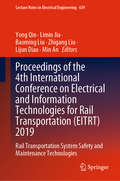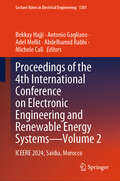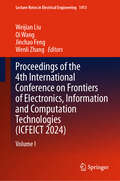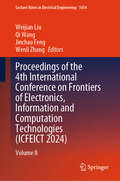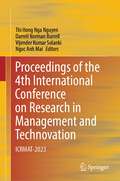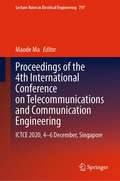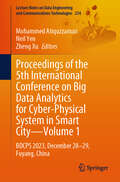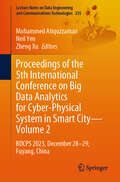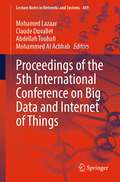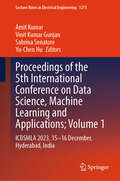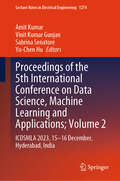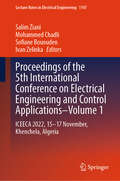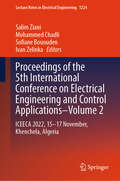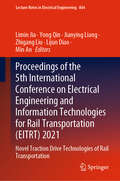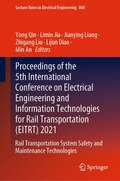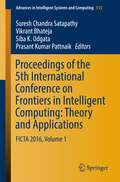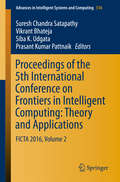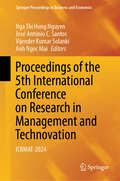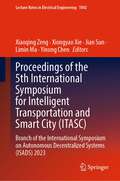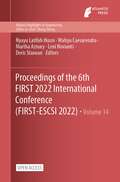- Table View
- List View
Proceedings of the 4th International Conference on Electrical and Information Technologies for Rail Transportation: Novel Traction Drive Technologies of Rail Transportation (Lecture Notes in Electrical Engineering #638)
by Zhigang Liu Limin Jia Yong Qin Lijun Diao Min An Baoming LiuThis book reflects the latest research trends, methods and experimental results in the field of electrical and information technologies for rail transportation, which covers abundant state-of-the-art research theories and ideas. As a vital field of research that is highly relevant to current developments in a number of technological domains, the subjects it covered include intelligent computing, information processing, Communication Technology, Automatic Control, etc. The objective of the proceedings is to provide a major interdisciplinary forum for researchers, engineers, academicians as well as industrial professionals to present the most innovative research and development in the field of rail transportation electrical and information technologies. Engineers and researchers in academia, industry, and the government will also explore an insight view of the solutions that combine ideas from multiple disciplines in this field. The volumes serve as an excellent reference work for researchers and graduate students working on rail transportation, electrical and information technologies.
Proceedings of the 4th International Conference on Electrical and Information Technologies for Rail Transportation: Rail Transportation Information Processing and Operational Management Technologies (Lecture Notes in Electrical Engineering #640)
by Zhigang Liu Limin Jia Yong Qin Lijun Diao Min An Baoming LiuThis book reflects the latest research trends, methods and experimental results in the field of electrical and information technologies for rail transportation, which covers abundant state-of-the-art research theories and ideas. As a vital field of research that is highly relevant to current developments in a number of technological domains, the subjects it covered include intelligent computing, information processing, Communication Technology, Automatic Control, etc. The objective of the proceedings is to provide a major interdisciplinary forum for researchers, engineers, academicians as well as industrial professionals to present the most innovative research and development in the field of rail transportation electrical and information technologies. Engineers and researchers in academia, industry, and the government will also explore an insight view of the solutions that combine ideas from multiple disciplines in this field. The volumes serve as an excellent reference work for researchers and graduate students working on rail transportation, electrical and information technologies.
Proceedings of the 4th International Conference on Electrical and Information Technologies for Rail Transportation: Rail Transportation System Safety and Maintenance Technologies (Lecture Notes in Electrical Engineering #639)
by Zhigang Liu Limin Jia Yong Qin Lijun Diao Min An Baoming LiuThis book reflects the latest research trends, methods and experimental results in the field of electrical and information technologies for rail transportation, which covers abundant state-of-the-art research theories and ideas. As a vital field of research that is highly relevant to current developments in a number of technological domains, the subjects it covered include intelligent computing, information processing, Communication Technology, Automatic Control, etc. The objective of the proceedings is to provide a major interdisciplinary forum for researchers, engineers, academicians as well as industrial professionals to present the most innovative research and development in the field of rail transportation electrical and information technologies. Engineers and researchers in academia, industry, and the government will also explore an insight view of the solutions that combine ideas from multiple disciplines in this field. The volumes serve as an excellent reference work for researchers and graduate students working on rail transportation, electrical and information technologies.
Proceedings of the 4th International Conference on Electronic Engineering and Renewable Energy Systems - Volume 2: ICEERE 2024, Saidia, Morocco (Lecture Notes in Electrical Engineering #1301)
by Bekkay Hajji Abdelhamid Rabhi Adel Mellit Antonio Gagliano Michele CalìThis book includes papers presented at the 4th International Conference on Electronic Engineering and Renewable Energy (ICEERE 2024), held in Saidia, Morocco, which focus on the application of artificial intelligence techniques, emerging technology, and the Internet of things in electrical and renewable energy systems, including hybrid systems, micro-grids, networking, smart health applications, smart grid, mechatronics, and electric vehicles. It particularly focuses on new renewable energy technologies for agricultural and rural areas to promote the development of the Euro-Mediterranean region. Given its scope, the book is of interest to graduate students, researchers, and practicing engineers working in the fields of electronic engineering and renewable energy. The book represents Volume 2 for this conference proceedings, which consists of a 2-volume book series
Proceedings of the 4th International Conference on Electronic Engineering and Renewable Energy Systems—Volume 1: ICEERE 2024, Saidia, Morocco (Lecture Notes in Electrical Engineering #1306)
by Bekkay Hajji Abdelhamid Rabhi Adel Mellit Antonio Gagliano Michele CalìThis book includes papers presented at the 4th International Conference on Electronic Engineering and Renewable Energy (ICEERE 2024), held in Saidia, Morocco, which focus on the application of artificial intelligence techniques, emerging technology, and the Internet of things in electrical and renewable energy systems, including hybrid systems, micro-grids, networking, smart health applications, smart grid, mechatronics, and electric vehicles. It particularly focuses on new renewable energy technologies for agricultural and rural areas to promote the development of the Euro-Mediterranean region. Given its scope, the book is of interest to graduate students, researchers, and practicing engineers working in the fields of electronic engineering and renewable energy. The book represents Volume 1 for this conference proceedings, which consist of a 2-volume book series
Proceedings of the 4th International Conference on Frontiers in Intelligent Computing: Theory and Applications (FICTA) 2015
by Swagatam Das Samarjit Kar Suresh Chandra Satapathy Jyotsna Kumar Mandal Tandra PalThe proceedings of the 4th International Conference on Frontiers in Intelligent Computing: Theory and Applications 2015 (FICTA 2015) serves as the knowledge centre not only for scientists and researchers in the field of intelligent computing but also for students of post-graduate level in various engineering disciplines. The book covers a comprehensive overview of the theory, methods, applications and tools of Intelligent Computing. Researchers are now working in interdisciplinary areas and the proceedings of FICTA 2015 plays a major role to accumulate those significant works in one arena. The chapters included in the proceedings inculcates both theoretical as well as practical aspects of different areas like Nature Inspired Algorithms, Fuzzy Systems, Data Mining, Signal Processing, Image processing, Text Processing, Wireless Sensor Networks, Network Security and Cellular Automata.
Proceedings of the 4th International Conference on Frontiers of Electronics, Information and Computation Technologies: Volume I (Lecture Notes in Electrical Engineering #1413)
by Qi Wang Wenli Zhang Weijian Liu Jinchao FengThis book contains papers that have been carefully compiled from the fourth International Conference on Frontiers of Electronics, Information and Computation Technologies (ICFEICT), which was held in Beijing from June 22 to June 24, 2024. These papers have undergone rigorous review processes and adhere to strict standards. The primary goal of the conference is to promote research and development efforts in these areas while fostering the exchange of scientific information. The intended audience for the papers presented at ICFEICT 2024 will primarily be leading academic scientists, researchers, scholars, educators, developers, engineers, students, and practitioners working globally in the areas of electronics engineering, communications, and computing.
Proceedings of the 4th International Conference on Frontiers of Electronics, Information and Computation Technologies: Volume II (Lecture Notes in Electrical Engineering #1414)
by Qi Wang Wenli Zhang Weijian Liu Jinchao FengThis book contains papers that have been carefully compiled from the fourth International Conference on Frontiers of Electronics, Information and Computation Technologies (ICFEICT), which was held in Beijing from June 22 to June 24, 2024. These papers have undergone rigorous review processes and adhere to strict standards. The primary goal of the conference is to promote research and development efforts in these areas while fostering the exchange of scientific information. The intended audience for the papers presented at ICFEICT 2024 will primarily be leading academic scientists, researchers, scholars, educators, developers, engineers, students, and practitioners working globally in the areas of electronics engineering, communications, and computing.
Proceedings of the 4th International Conference on Research in Management and Technovation: ICRMAT-2023
by Vijender Kumar Solanki Thi Hong Nga Nguyen Darrell Norman Burrell Ngoc Anh MaiThis book brings together selected papers from the Fourth International Conference on Research in Management and Technovation held in Hanoi, Vietnam, in 2023, with a focus on defining action-based plans around innovation and technology as tools for societal and organizational advancement. Today's business and technology intersections are obvious. Cloud-sharing, scheduling, and virtual conference rooms are some of the few examples. Cutting-edge academic researchers use business and technology every day to navigate volatility, uncertainty, complexity, and ambiguity (VUCA) in the environment, make good judgments, stay ahead of the competition, better their marketing tactics, and create new business initiatives. The research highlighted in this book aims to demonstrate how technology empowers managers, strategists, and researchers to make decisions that are data-driven and effective.
Proceedings of the 4th International Conference on Telecommunications and Communication Engineering: ICTCE 2020, 4-6 December, Singapore (Lecture Notes in Electrical Engineering #797)
by Maode MaThe book is presents the papers presented at the 4th International Conference on Telecommunications and Communication Engineering (ICTCE 2020) held on 4 -6 December, in Singapore. It covers advanced research topics in the field of computer communication and networking organized into the topics of emerging technologies of wireless communication and networks, 5G wireless communication and networks, information and network security, internet of things and fog computing. These advanced research topics are taking the lead and representing the trend of the recent academic research in the field of computer communication and networking. It is expected that the collection and publication of the research papers with the advanced topics listed in this book will further promote high standard academic research in the field and make a significant contribution to the development of economics and human society.
Proceedings of the 5th International Conference on Big Data Analytics for Cyber-Physical System in Smart City—Volume 1: BDCPS 2023, December 28–29, Fuyang, China (Lecture Notes on Data Engineering and Communications Technologies #234)
by Mohammed Atiquzzaman Zheng Xu Neil YenThis book gathers a selection of peer-reviewed papers presented at the 5th Big Data Analytics for Cyber-Physical System in Smart City (BDCPS 2023) conference, held in Fuyang, China, on December 28–29. The contributions, prepared by an international team of scientists and engineers, cover the latest advances and challenges made in the field of big data analytics methods and approaches for the data-driven co-design of communication, computing, and control for smart cities. Given its scope, it offers a valuable resource for all researchers and professionals interested in big data, smart cities, and cyber-physical systems.
Proceedings of the 5th International Conference on Big Data Analytics for Cyber-Physical System in Smart City—Volume 2: BDCPS 2023, December 28–29, Fuyang, China (Lecture Notes on Data Engineering and Communications Technologies #235)
by Mohammed Atiquzzaman Zheng Xu Neil YenThis book gathers a selection of peer-reviewed papers presented at the 5th Big Data Analytics for Cyber-Physical System in Smart City (BDCPS 2023) conference, held in Fuyang, China, on December 28–29. The contributions, prepared by an international team of scientists and engineers, cover the latest advances and challenges made in the field of big data analytics methods and approaches for the data-driven co-design of communication, computing, and control for smart cities. Given its scope, it offers a valuable resource for all researchers and professionals interested in big data, smart cities, and cyber-physical systems.
Proceedings of the 5th International Conference on Big Data and Internet of Things (Lecture Notes in Networks and Systems #489)
by Mohamed Lazaar Mohammed Al Achhab Claude Duvallet Abdellah TouhafiThis book is a collection of papers in the research area of big data, cloud computing, cybersecurity, machine learning, deep learning, e-learning, Internet of Things, reinforcement learning, information system, social media and natural language processing. This book includes papers presented at the 5th International Conference on Big Data Cloud and Internet of Things, BDIoT 2021 during March 17–18, 2021, at ENSIAS, Mohammed V University in Rabat, Morocco.
Proceedings of the 5th International Conference on Data Science, Machine Learning and Applications; Volume 1: ICDSMLA 2023, 15–16 December, Hyderabad, India (Lecture Notes in Electrical Engineering #1273)
by Amit Kumar Yu-Chen Hu Vinit Kumar Gunjan Sabrina SenatoreThis book (Volume 1) includes peer reviewed articles from the 5th International Conference on Data Science, Machine Learning and Applications, 2023, held at the G Narayanamma Institute of Technology and Sciences, Hyderabad on 15-16th December, India. ICDSMLA is one of the most prestigious conferences conceptualized in the field of Data Science & Machine Learning offering in-depth information on the latest developments in Artificial Intelligence, Machine Learning, Soft Computing, Human Computer Interaction, and various data science & machine learning applications. It provides a platform for academicians, scientists, researchers and professionals around the world to showcase broad range of perspectives, practices, and technical expertise in these fields. It offers participants the opportunity to stay informed about the latest developments in data science and machine learning.
Proceedings of the 5th International Conference on Data Science, Machine Learning and Applications; Volume 2: ICDSMLA 2023, 15–16 December, Hyderabad, India (Lecture Notes in Electrical Engineering #1274)
by Amit Kumar Yu-Chen Hu Vinit Kumar Gunjan Sabrina SenatoreThis book includes peer reviewed articles from the 5th International Conference on Data Science, Machine Learning and Applications, 2023, held at the G Narayanamma Institute of Technology and Sciences, Hyderabad on 15-16th December, India. ICDSMLA is one of the most prestigious conferences conceptualized in the field of Data Science & Machine Learning offering in-depth information on the latest developments in Artificial Intelligence, Machine Learning, Soft Computing, Human Computer Interaction, and various data science & machine learning applications. It provides a platform for academicians, scientists, researchers and professionals around the world to showcase broad range of perspectives, practices, and technical expertise in these fields. It offers participants the opportunity to stay informed about the latest developments in data science and machine learning.
Proceedings of the 5th International Conference on Electrical Engineering and Control Applications–Volume 1: ICEECA 2022, 15–17 November, Khenchela, Algeria (Lecture Notes in Electrical Engineering #1147)
by Ivan Zelinka Mohammed Chadli Sofiane Bououden Salim ZianiThis book gathers papers presented during the 5th International Conference on Electrical Engineering and Control Applications (ICEECA 2022), held on November, 15–17, 2022, Khenchela, Algeria. It covers new control system models, troubleshooting tips, and complex system requirements, such as increased speed, precision, and remote capabilities. Additionally, the book discusses not only the engineering aspects of signal processing and various practical issues in the broad field of information transmission, but also novel technologies for communication networks and modern antenna design. The later part of the book covers important related topics such as fault diagnosis and fault-tolerant control strategies for nonlinear systems and alternative energy sources. This book is intended for researchers, engineers, and advanced postgraduate students in the fields of control and electrical engineering, computer science, signal processing, as well as mechanical and chemical engineering.
Proceedings of the 5th International Conference on Electrical Engineering and Control Applications–Volume 2: ICEECA 2022, 15–17 November, Khenchela, Algeria (Lecture Notes in Electrical Engineering #1224)
by Ivan Zelinka Mohammed Chadli Sofiane Bououden Salim ZianiThis book gathers papers presented during the 5th International Conference on Electrical Engineering and Control Applications (ICEECA 2022), held on November, 15–17, 2022, Khenchela, Algeria. It covers new control system models, troubleshooting tips, and complex system requirements, such as increased speed, precision, and remote capabilities. Additionally, the book discusses not only the engineering aspects of signal processing and various practical issues in the broad field of information transmission, but also novel technologies for communication networks and modern antenna design. The later part of the book covers important related topics such as fault diagnosis and fault-tolerant control strategies for nonlinear systems and alternative energy sources. This book is intended for researchers, engineers, and advanced postgraduate students in the fields of control and electrical engineering, computer science, signal processing, as well as mechanical and chemical engineering.
Proceedings of the 5th International Conference on Electrical Engineering and Information Technologies for Rail Transportation: Novel Traction Drive Technologies of Rail Transportation (Lecture Notes in Electrical Engineering #864)
by Zhigang Liu Limin Jia Yong Qin Lijun Diao Min An Jianying LiangThis book reflects the latest research trends, methods and experimental results in the field of electrical and information technologies for rail transportation, which covers abundant state-of-the-art research theories and ideas. As a vital field of research that is highly relevant to current developments in a number of technological domains, the subjects it covered include intelligent computing, information processing, communication technology, automatic control, etc. The objective of the proceedings is to provide a major interdisciplinary forum for researchers, engineers, academicians and industrial professionals to present the most innovative research and development in the field of rail transportation electrical and information technologies. Engineers and researchers in academia, industry and government will also explore an insightful view of the solutions that combine ideas from multiple disciplines in this field. The volumes serve as an excellent reference work for researchers and graduate students working on rail transportation and electrical and information technologies.
Proceedings of the 5th International Conference on Electrical Engineering and Information Technologies for Rail Transportation: Rail Transportation Information Processing and Operational Management Technologies (Lecture Notes in Electrical Engineering #867)
by Zhigang Liu Limin Jia Yong Qin Lijun Diao Min An Jianying LiangThis book reflects the latest research trends, methods, and experimental results in the field of electrical and information technologies for rail transportation, which covers abundant state-of-the-art research theories and ideas. As a vital field of research that is highly relevant to current developments in a number of technological domains, the subjects it covered include intelligent computing, information processing, communication technology, automatic control, etc. The objective of the proceedings is to provide a major interdisciplinary forum for researchers, engineers, academicians, and industrial professionals to present the most innovative research and development in the field of rail transportation electrical and information technologies. Engineers and researchers in academia, industry, and government will also explore an insightful view of the solutions that combine ideas from multiple disciplines in this field. The volumes serve as an excellent reference work for researchers and graduate students working on rail transportation and electrical and information technologies.
Proceedings of the 5th International Conference on Electrical Engineering and Information Technologies for Rail Transportation: Rail Transportation System Safety and Maintenance Technologies (Lecture Notes in Electrical Engineering #868)
by Zhigang Liu Limin Jia Yong Qin Lijun Diao Min An Jianying LiangThis book reflects the latest research trends, methods, and experimental results in the field of electrical and information technologies for rail transportation, which covers abundant state-of-the-art research theories and ideas. As a vital field of research that is highly relevant to current developments in a number of technological domains, the subjects it covered include intelligent computing, information processing, communication technology, automatic control, etc. The objective of the proceedings is to provide a major interdisciplinary forum for researchers, engineers, academicians, and industrial professionals to present the most innovative research and development in the field of rail transportation electrical and information technologies. Engineers and researchers in academia, industry, and government will also explore an insightful view of the solutions that combine ideas from multiple disciplines in this field. The volumes serve as an excellent reference work for researchers and graduate students working on rail transportation and electrical and information technologies.
Proceedings of the 5th International Conference on Frontiers in Intelligent Computing: Theory and Applications
by Suresh Chandra Satapathy Vikrant Bhateja Siba K. Udgata Prasant Kumar PattnaikThe book is a collection of high-quality peer-reviewed research papers presented at International Conference on Frontiers of Intelligent Computing: Theory and applications (FICTA 2016) held at School of Computer Engineering, KIIT University, Bhubaneswar, India during 16 - 17 September 2016. The book presents theories, methodologies, new ideas, experiences and applications in all areas of intelligent computing and its applications to various engineering disciplines like computer science, electronics, electrical and mechanical engineering.
Proceedings of the 5th International Conference on Frontiers in Intelligent Computing: Theory and Applications
by Suresh Chandra Satapathy Vikrant Bhateja Siba K. Udgata Prasant Kumar PattnaikThe book is a collection of high-quality peer-reviewed research papers presented at International Conference on Frontiers of Intelligent Computing: Theory and applications (FICTA 2016) held at School of Computer Engineering, KIIT University, Bhubaneswar, India during 16 - 17 September 2016. The book aims to present theories, methodologies, new ideas, experiences, applications in all areas of intelligent computing and its applications to various engineering disciplines like computer science, electronics, electrical, mechanical engineering, etc.
Proceedings of the 5th International Conference on Research in Management and Technovation: ICRMAT-2024 (Springer Proceedings in Business and Economics)
by Vijender Kumar Solanki Nga Thi Hong Nguyen José António C. Santos Anh Ngoc MaiThis book, bringing together selected papers from the 5th International Conference on Research in Management and Technovation, explores the global impact of technology, corporate management, and innovation. In a time of fast growth and widespread tech use, the relationship between business and technology has transformed at a rapid pace. From computers and automation to dealing with the effects of COVID-19, it highlights the need for forward-thinking leaders. Both new and established companies now prioritize blending business and technology in their plans, stressing the importance of creative strategies. The conference promotes an interdisciplinary approach, looking at how these areas connect instead of keeping them separate. Beyond common tech practices like virtual meetings, the book shows how business and technology affect decision-making in uncertain situations. The research shared in this book focuses on making practical plans for progress using innovations and technology, seeing them as crucial tools for society and organizations. Technology is portrayed as a helpful tool, allowing managers, strategists, and researchers to make smart decisions that demonstrate the strength of business and technology in a constantly changing global landscape.
Proceedings of the 5th International Symposium for Intelligent Transportation and Smart City: Branch of the International Symposium on Autonomous Decentralized Systems (ISADS) 2023 (Lecture Notes in Electrical Engineering #1042)
by Xiaoqing Zeng Xiongyao Xie Jian Sun Limin Ma Yinong ChenThis book presents research advances in intelligent transportation and smart city in detail, mainly focusing on green traffic and urban utility tunnels, presented at the 5th International Symposium for Intelligent Transportation and Smart City (ITASC 2022) held at Tongji University, Shanghai, on May 20-21, 2022. It is also branch of the International Symposium on Autonomous Decentralized Systems (ISADS) 2023. Due to rapid development in the domain of intelligent transportation and smart city, many popular topics are included, such as the 2BMW system (Bus, Bike, Metro and Walking), transportation safety and environment protection, urban utility design and application, the application of BIM in the city design. This book collects papers with high quality, including some authoritative scholars and most experienced engineers’ latest achievements, which will provide guidance to those both in universities and entrepreneurs in the field of transportation and urban planning. The first conference in the ITASC series was held in 2013 as a workshop of the International Symposium on Autonomous Decentralized System (ISADS) in Mexico City. The second to fourth were held in May 2015, 2017 and 2019, respectively, in Tongji University, Shanghai.
Proceedings of the 6th FIRST 2022 International Conference (Atlantis Highlights in Engineering #14)
by Wahyu Caesarendra Nyayu Latifah Husni Martha Aznury Leni Novianti Deris StiawanThis is an open access book.The 6th FIRST 2022 International Conference offers the researchers in academics, industries, and governments, a conference, for exchanging, sharing, following up, and discussing the results of the latest researches, industry’s needs, and government regulatory policies. The 6th FIRST 2022 International Conference facilitates the participants from all over the world to meet face to face to open chances in establishing connections and collaboration among them.


